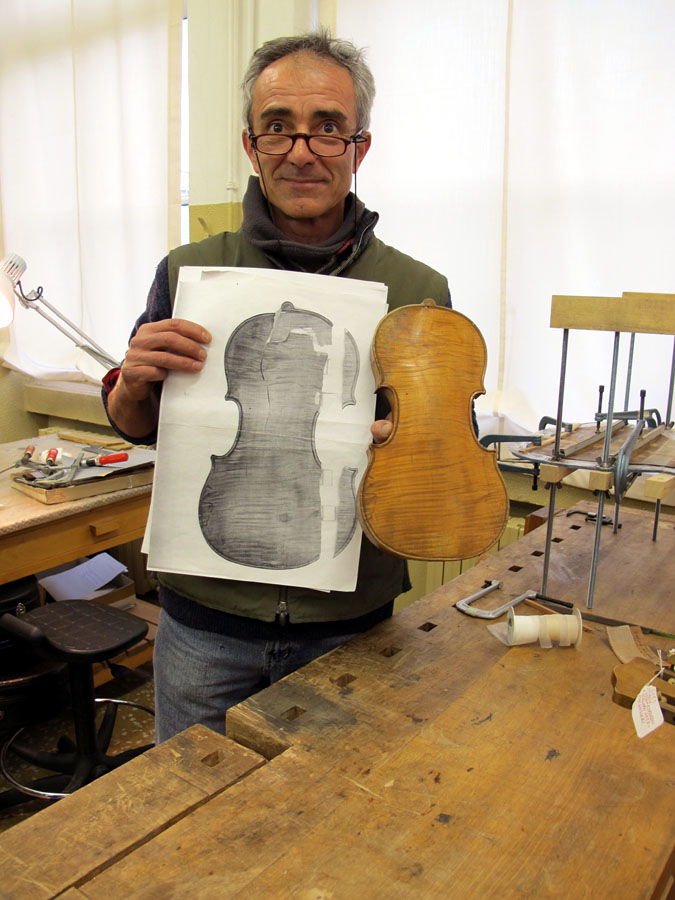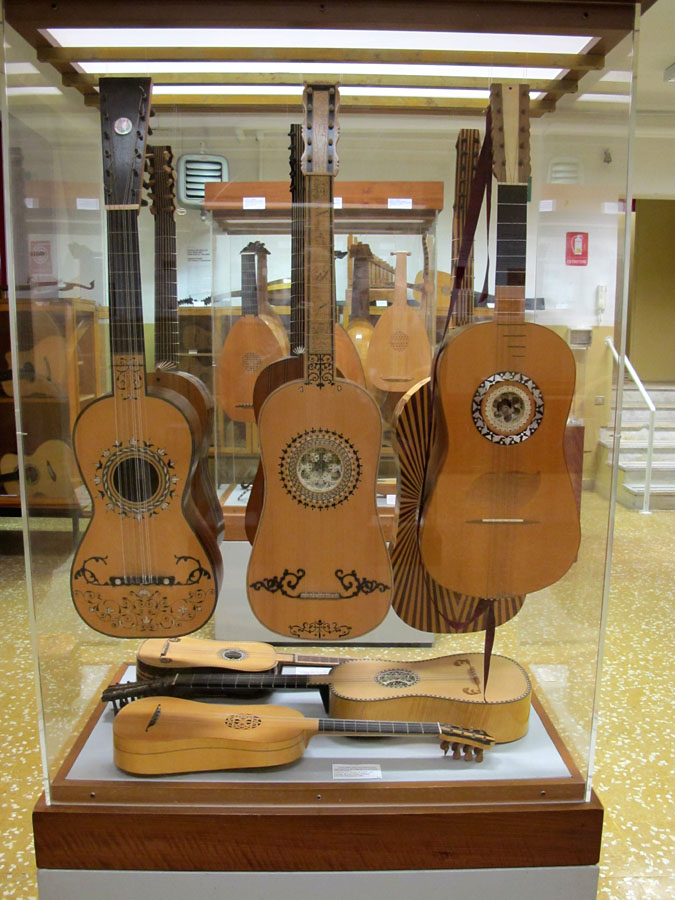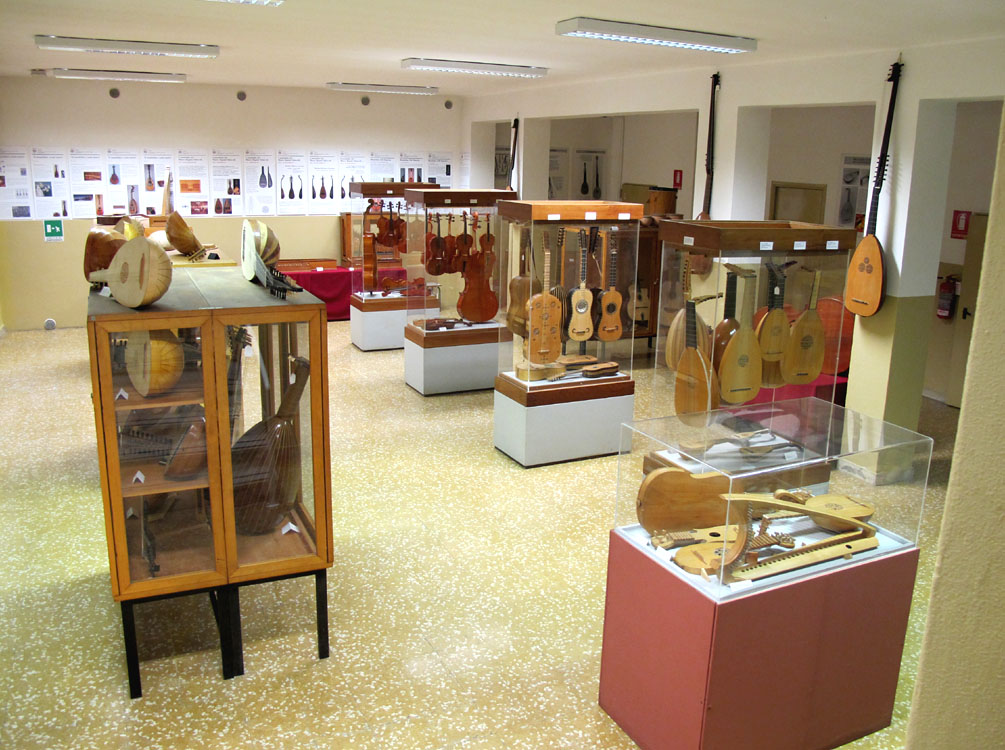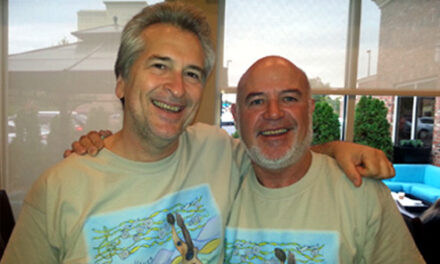 On our final day in Milan, Giulia and Hiroki were free and kindly offered to drive us around.
On our final day in Milan, Giulia and Hiroki were free and kindly offered to drive us around.
I had expressed an interest to Giorgio Ferraris the night before in seeing the Lutherie School, and he graciously made himself available for a couple of hours this morning.
After meeting the school’s Director, Virginia Villa, and receiving a gift of an elaborate book about the school from her, Giorgio took us around to the various instrument-building classes.
Either this or another lute class was led by Lorenzo Lippi, who is a good friend of Alex Timmerman (“bass guitar” – ie: harp guitar – researcher)

Building an Italian mandocello

In the Restoration laboratory, headed by Gabriele Negri

Gradually and methodically closing an open crack of an Armando Giulietti guitar. I saw a lot of new (to me) tricks of the trade in my hour in this lab alone.

The ribs of a mandolin being carefully aligned during re-gluing

Significant tortoiseshell repair and replacement required

Gabriele with rare violin from La Scala, with “before” photo. He explained that it was crushed when someone inadvertently sat on it. The repairs are largely invisible.
Downstairs, the school maintains a permanent collection of examples by its students. I was drooling over dozens of fine reproductions of all the variant forms of historical lutes and guitars, an education in itself. These are all exacting replicas of surviving instruments from important collections. The school’s very strict rules include doing something over if the measurement is off by more than a tenth of a millimeter.

Baroque guitars and amazing reproduction of the huge vihuela of the Musée Jacquemart-Andrée

Side view

The other side of the case, with more Baroque guitars

A beautiful rosette. Giorgio says that this student went on to become a full-time artisan doing nothing but rosettes for museums, collectors and builders of historical replicas all over the world.

The lutes in this case represent the enormous range of sizes and pitches.

Opposite side

The side of the case and an unusual double-headed lute

These lutes include (I believe) an arciliuto (center) and a liuto attiorbato (right); distinct forms/tunings/variants
Honestly, they must have had every possible version of historical lute reproduced here, all the more interesting and enlightening to me, after absorbing (and continuing to!) the new Lute book I’m proud to offer in the States. Again, I could have spent a day here, bombarding Giorgio with endless questions.

Some of these fascinating reproductions are based on ancient illustrations, as no instruments have survived. I was quite amazed by the unusual, angled “block frets” of the two citolas.

Opposite side of the case

Even a copy of the rare arch-cittern I saw the day before at Castle Sforza. Lying next to this on top of the case was a student’s perfect reproduction Weissenborn!
What a great visit – thanks, Giorgio, and all the instructors who gave us their time!
We were then treated to dinner by Giulia and Hiroki at one of their favorite traditional Milanese restaurants. On the way back to the train station for the trip home, Hiroki and Giulia took us to their favorite book store to browse for our last half hour. I found no cool new music books, but was thrilled to see my friend Jonathan Kellerman’s beautiful guitar book (which I also stock) over there!

Back at Franco’s, we had a nice dinner with Enrico De Filippi and the Gambetta’s: Beppe and Federica (most excellent cook Margarita is taking the photo). Enrico we had seen a lot of during our last visit: wine merchant and fellow guitar music aficionado who helps with Taraffo research (and gave me several new pieces of historical harp guitar music he tracked down on the web). The evening was not all socializing – Franco, Beppe and I were obliged to discuss and plan our comments for the following day’s presentation. Mostly, I was instructed to “behave.”

Next time: Standing room only at the “Memories of Pasquale Taraffo” public presentation & concert!







